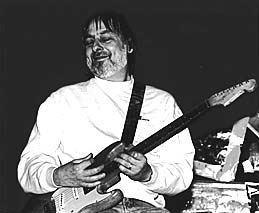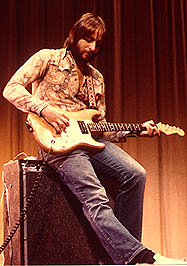When I wrote the below pieces a good number of years ago, the two items it addresses were my absolute “go-to” pieces of gear. As time has progressed, I’ve become endeared to a number of new guitars and amps. (You might be interested to check out some of my other posts on gear, which will be much more up-to-date.)
The Strat
 It’s a 1963 Fender Stratocaster with a 930xx serial number. I bought it used in 1965 from Jimmy’s Music Shop on West 48th street (New York’s ‘Tin Pan Alley’). Originally, the guitar had a sunburst finish.
It’s a 1963 Fender Stratocaster with a 930xx serial number. I bought it used in 1965 from Jimmy’s Music Shop on West 48th street (New York’s ‘Tin Pan Alley’). Originally, the guitar had a sunburst finish.
The neck was broken in 1965, after an unfortunate meeting with the trunk of my drummer’s Triumph Spitfire. I’ve always enjoyed the convenience of soft gig bags; this was one instance where the protection of a hard case would have come in handy. So I replaced the neck immediately (I think I had to wait a week or so for delivery of the ‘special part’ from California) with a 1965 Fender Stratocaster neck. The reason that the headstock doesn’t sport the Fender decal is that in 1966 I painted the guitar metalflake silver, and was thorough enough to do the headstock too, covering over the original decal (Ooops). Two years later, I sanded the guitar down to the bare wood you see today, and even though I’ve had many offers of ‘original-style’ decals, I’ve left it bare.
The frets have been in place since my last refret of (hold onto your hat-) 1972! I scored some ‘invincible’ Gibson bass fret wire, and it’s still sitting there atop my rosewood. I have to grind and polish the frets every 2 – 5 years. I suspect that one of the reasons the frets have lasted as long as they have is that I use extremely light gauge strings.
The string gauges are: E or 1st 009 / B or 2nd 010 / G or 3rd 013 / D or 4th 026 / A or 5th 036 / E or 6th 046. [Note: I find these particular gauges the right ones for this guitar – I use different string combinations for different instruments.]
The pickups: The neck pickup is a 1969 Gibson Humbucker (installed in ’69 at the Barney Kessel Guitar Shop in L.A.) The middle pickup is a Zexcoil SV-5 (noise-cancelling), in since 2014. I wouldn’t touch my bridge pickup for love nor money. It’s the original, and while it may not have the grounding of the other two, boy can it scream! Serious Fender treble.
The tremolo arm: What tremolo arm? Around 1968, I decided to secure the spring assembly that allows the bridge to move. I used a block of hardwood as a wedge, and tightened the two large screws ’til they could go no further. For playing music that requires ‘the bar’ I use a different guitar.
Other parts: Most of the hardware (with the exception of the pickguard) has been replaced at least once due to normal wear-and-tear. Wherever possible, I’ve stayed true to the original parts. These include the machine-head tuning pegs, the individual bridge saddles, the nut, volume and tone controls, and the three-way switch (which I ‘pinch’ with a pair of pliers, turning it into a DIY ‘five-way’ switch).
Miscellany
It’s a very sturdy instrument. In 1977, while touring with the Doobie Brothers, the guitar was run over by a stretch-limo at Teeterboro airport. It was in a Manny’s gig bag again. Luckily, all that happened was my MXR Phase 90 pedal made this big imprint on the surface of the leather case – the guitar was fine!
For the neck, I employ natural lemon oil polish, and for body I still prefer S.C. Johnson & Son “Lemon Pledge”. The routine is:
- Remove the strings
- With a warm, damp wash cloth, wipe the neck very thoroughly, I said very thoroughly; fret by fret – get all that ground-in dirt out…
- Followed by the toothbrush, further removing grit etc from where the metal of the fret meets the wood of the fingerboard… It was Gene Santini, bassist extraordinaire (Boz Scaggs, The Pointer Sisters et al), who hipped me to the toothbrush trick. In 1973, he and I were room-mates at the Miyako Hotel in San Francisco, playing for producer/ABC recording artist Thomas Jefferson Kaye. Gene was serious about brushing his frets, and buffing his fine leather shoes. Funny, the things you learn about people on the road.
- The damp cloth once again. The idea is to remove as much dirt and grime as possible before the next step.
- Finally, a modest amount of lemon oil on the neck, giving it 15 minutes or so to sink in, then wipe and buff well. Lemon Pledge is then sprayed onto a cloth. Work it well into the body, getting that shine.
- Now a new set of strings, well pulled and stretched, and you should feel like you’re driving a Ferrari.
What did it cost? Well, in 1965, a slice of pizza cost fifteen cents… The used Strat (including original dark brown Tolex hard case) cost me a whopping $175. If I remember correctly, the replacement neck was $55.
The 1969 Fender ‘hybrid’ Super Reverb Amp
 My first ‘serious’ amp was a 1960 Fender Concert – brown tolex, dark chocolate brown grille cloth – what a beauty! I sold it to a student in 1966 after buying a newer version of the same amp (whooops)! At the end of the sixties I moved on to the Fender Super Reverb, which was simply the next incarnation of the Fender Concert. I’ve always loved the sound of the guitar through ten inch speakers.
My first ‘serious’ amp was a 1960 Fender Concert – brown tolex, dark chocolate brown grille cloth – what a beauty! I sold it to a student in 1966 after buying a newer version of the same amp (whooops)! At the end of the sixties I moved on to the Fender Super Reverb, which was simply the next incarnation of the Fender Concert. I’ve always loved the sound of the guitar through ten inch speakers.
Reconstructed from four ‘cannibalized’ Super Reverb amps in the autumn of 1969, (shortly before I left SeaTrain), the speakers are two pairs of matching JBL 10″s – (2x’D series’ and 2x’F series’). Over the next six years, I had the electronics altered to:
a) Increase the amp’s output from 35 watts RMS to 100 watts RMS and
b) Allow for a ‘master’ volume control.
As far as the actual modifications go – I have no idea what’s been done, other than the fact that it’s got two extra tubes: a 6L6 and a 12AX7, and TWO power transformers! The mods were done by my friend Rich Koerner (aka ‘Bird’), owner of Time Electronics in New Jersey – He made a great job of it. David Spinozza said it’s his favorite amp …o.k. by me!
For more articles on my gear and mods, click here.